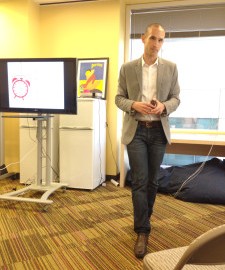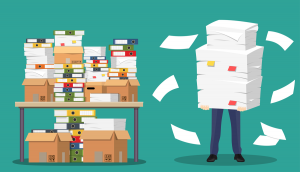How many apps do you have on your mobile phone? In the marketplace today, there are over 1.3 million mobile apps to choose from. The mobile app universe is growing and shows no sign of slowing down. And the number of apps used for work — whether approved or unapproved by IT and HR — is also accelerating. Employees want to use apps for work that look and feel like the consumer apps they use every day — often multiple times a day. We’re “hooked” and it’s no accident, says Nir Eyal, entrepreneur, and author of the book, Hooked: How to Build Habit-Forming Products.
 According to Eyal, the best apps are habit-forming because at their core they’re highly engaging. The habit-forming nature of these apps — like Facebook, Twitter, and mobile games and more — often causes employers a knee-jerk reaction to shut them down as a distraction. But we believe that instead of writing off consumer apps as a distraction, companies can learn from them to invest in business applications that their employees will not only love to use, but will also make them more efficient in their roles. After reading Hooked and meeting with Eyal, we asked ourselves, “Why wouldn’t employees use highly engaging mobile apps to work smarter and better?”
According to Eyal, the best apps are habit-forming because at their core they’re highly engaging. The habit-forming nature of these apps — like Facebook, Twitter, and mobile games and more — often causes employers a knee-jerk reaction to shut them down as a distraction. But we believe that instead of writing off consumer apps as a distraction, companies can learn from them to invest in business applications that their employees will not only love to use, but will also make them more efficient in their roles. After reading Hooked and meeting with Eyal, we asked ourselves, “Why wouldn’t employees use highly engaging mobile apps to work smarter and better?”
This way employers can approach designing the employee engagement experience similarly to the way they design the customer experience.
The Hook Model, developed by Eyal, can be used by employers as they design their employee engagement strategy. As companies select apps and tools for their employees, they can familiarize themselves with the Hook Model to better predict which apps employees will use consistently and which ones might not get very much engagement.
Often when companies are creating learning materials for employees and providing them with tools like company intranets and portals — they lose sight of the user experience, expecting employees to figure out how to navigate these difficult-to-use applications. As the consumerization of IT persists, companies that engage their employees with the right tools and information will increase productivity and efficiency, while decreasing the amount of bad investments in tools and apps that get little to no use.
Instead, companies can ask themselves, “What kind of technology are employees drawn to without someone telling them to use it?” The Hook Model answers this question and using it can easily become second nature when assessing applications for employees. One very simple way to start is just by thinking about which apps engage you the most and why. Companies that do this will see more widespread adoption and engagement with the tools they invest in.
So, what should you look for in a product or software?
Recently, the SocialChorus product and engineering teams met with Eyal to find out more about the “Hooked” process and how is can be applied to increasing employee engagement.
Here’s Eyal’s breakdown of the Hook Model:
1. Trigger: Every action from a user starts a trigger. According to Eyal, there are two types of triggers: internal and external. An example of an external trigger would be a push notification (pretty straightforward). An external trigger is generally sent from the app to the user, with the intention to motivate them to engage with the app.
Internal triggers come from the user and can be loosely defined as their personal motivation for using your app. These are trickier to guess and manage because they’re based on the emotions of the user. An example of an internal trigger would be the feeling of boredom that then leads a user to solve that problem and open Pinterest or Instagram.
Eyal advises companies to think about how to align internal and external triggers, such as sending a timely push notifications when the user may be most likely to want to use your app. For marketing and communications professionals, this thought process comes naturally, we’re constantly asking ourselves what will get our desired audience to convert on a call to action.
2. Action: After receiving the trigger, this is the desired action that the user performs, like opening your app and engaging with the content. However, so many companies get stuck on confusing the user by offering them too many actions once they open the app. While it seems simple, it’s important to spend time on deciding what actions you want the user to perform and when. This can help decrease investing in business applications that offer too many features — many of which the every day user won’t need.
3. Reward: What does the user get for following through on the desired action? Rewards can be as simple as allowing users to check completed items off of a list (a reward that many productivity apps offer). Another reward can be as simple as providing users with relevant information that they need to be successful in their role.
4. Investment: Do employees show investment in the apps you provide? People invest for future rewards from apps that they love, explains Eyal. They show that they are committed to your app when they invest their resources, such as time, energy, and more. This also increases the likelihood that they’ll continue to engage with your app regularly.
Understanding The Employee Experience
The Hook Model provides a way to understand and improve the employees’ experience with the information and tools that we give them. Using this model, it should be no surprise to understand why, for example, a communication tool like Slack, which includes a mobile app and push notifications (external triggers) is so successful. Alternatively, an employee intranet that only has a desktop version and is difficult to navigate (i.e. features overload), won’t be able to sustain ongoing engagement.
At SocialChorus, we’re actively curious about what makes applications, specifically mobile applications, so engaging, entertaining and even addictive. Our company culture is very “mobile-first,” all of our employees are on smartphones and debates over iOS versus Android are ongoing (#iOS4life). So an app — no matter how important — that doesn’t have an easy-to-use mobile component, doesn’t get as much engagement on a day-to-day basis and almost certainly doesn’t succeed in getting engagement from employees after hours or on the weekend.
Apps that do get round-the-clock use, apps that we’re “hooked” on, such as Slack, Trello, Basecamp, Instagram and more — all have great mobile experiences and are our go-to’s when we want to accomplish a task, be entertained or seek out information (i.e. the rewards we value).
To learn more about Hooked and Nir Eyal, see his Slideshare presentation here.
(323)






